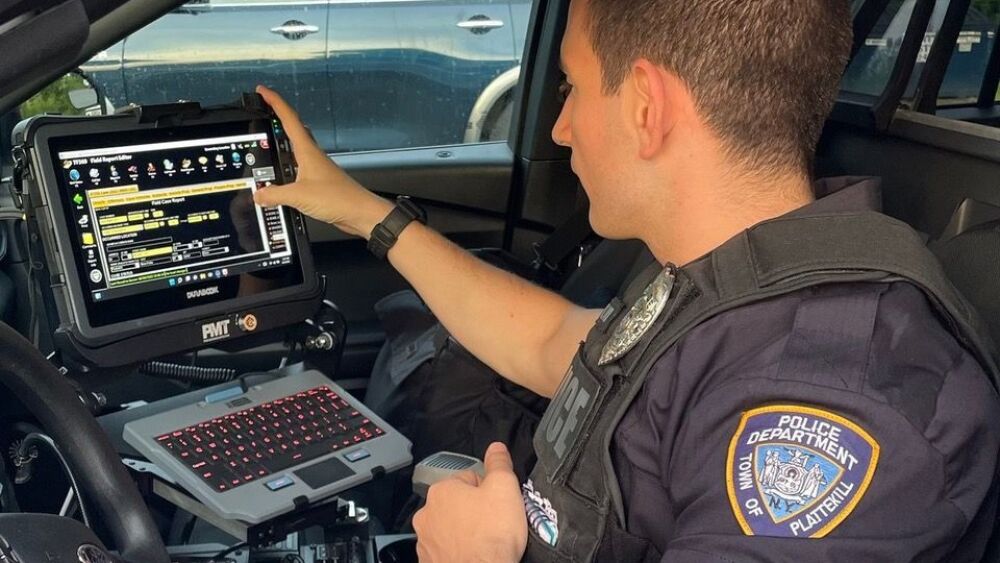By Sasha Wang
A law enforcement officer’s principal job is to keep residents safe. At a very basic level, they keep the peace, arrest suspects, assist citizens, and maintain law and order. Only it is not that simple. There are countless steps involved in performing each of those functions.
Rugged computers are designed to help law enforcement professionals meet the challenges they face in the field. These devices are designed from the inside out to work in extreme temperatures, be impervious to being dropped, resist shocks and vibrations, be dustproof and waterproof, and be mounted in a vehicle for ease of use. When combined with the right software, rugged computers can dramatically improve an officer’s efficiency in the field.
There are three key areas where departments can combine a rugged computer with specialized software to improve efficiency.
1. Getting officers where they are needed most
It is essential for both the officer and resident safety that officers go where they are needed most, quickly and with as much information as possible.
Dispatch – Software offers improved methods of dispatching staff and resources to incident sites and decreases response time. Programs can include turn-by-turn mapping and geolocation tracking (determining the exact location of a computer, cell phone, networking device, etc., based on geographical coordinates and measurements).
Scheduling – Software is necessary for departments/agencies as it helps manage work schedules, days off, vacation and sick leave.
2. Real-time information at the tip of their fingers
With the internet connectivity of a rugged computer, officers have access in their vehicle to all the information they can access while being on patrol.
Background check – Perhaps one of law enforcement’s most used/viewed software programs. Provides a wide range of personal and private information key to knowing who they are dealing with.
Criminal Record Database – Software offers a practical means of gathering, analyzing and using information to prevent future crimes from occurring, helping to identify criminal activity trends in the area.
Automatic License Plate Readers – With their specialized cameras and software, ALPRs are useful to determine if a law enforcement agency has flagged a car, a car has been reported stolen, if a car’s registration is current, etc.
3. Reporting and managing information in the field
The large volume of information a department generates daily is streamlined when officers can do these tasks immediately and efficiently in the field:
Traffic Citation – Software automates the traffic-citation writing process. This results in fewer errors and takes less time to complete, reducing an officer’s exposure to harm while standing alongside the road writing a citation. It also instantly delivers citations electronically to the court for processing.
Field Reporting – Applications help to create and file real-time incident reports from the scene quickly.
Evidence Management – Provides a means to control digital and physical evidence without using paper. It employs the latest barcode technology that is integrated with specialized software to initiate and manage the chain of custody.
Investigation – Sometimes referred to as investigative case management or case management software. Ensures smooth investigations by providing means to collect, access, organize and manage investigations, which can then be shared/viewed by other agencies.
With the advent of digital technology and its many facets, officers have new tools at their disposal. Computer software designed especially for law enforcement saves time, provides better accuracy and organization, facilitates communications between departments and other agencies, ensures safe storage and transfer of data/files, and can be securely accessed virtually anywhere and anytime. Such software easily accommodates written files, photographs, charts, videos, audio files and virtually anything else that is up-loadable.
It would be safe to say a rugged mobile device is the brawn and law enforcement-specific software is the brains. Both are necessary in today’s world, where digital smarts and toughness are a perfect combo to help ensure law enforcement officers get through their shifts safely.
About the author
Sasha Wang is head of global sales and marketing for DURABOOK. She recently became the president of Durabook Americas and has been highly successful in the areas of global product planning, sales and marketing, as well as various management positions within the rugged-computer industry for over 15 years.













